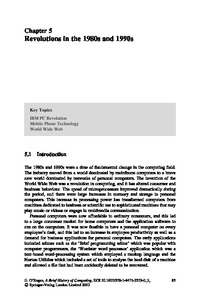Revolutions in the 1980s and 1990sZu finden in: A Brief History of Computing, 2012
 |
 |
 Diese Seite wurde seit 13 Jahren inhaltlich nicht mehr aktualisiert.
Unter Umständen ist sie nicht mehr aktuell.
Diese Seite wurde seit 13 Jahren inhaltlich nicht mehr aktualisiert.
Unter Umständen ist sie nicht mehr aktuell.
 Zusammenfassungen
Zusammenfassungen
 Chapter 5 considers the revolutions in computing that took place in the 1980s
and 1990s. This included the introduction of the IBM personal computer, the move
from mainframes to networks of personal computers and client-server architecture
and the development of mobile phone technology which transformed the existing
communication paradigm of that between places to communication between
people. Finally, the World Wide Web and its impact on society are discussed.
Chapter 5 considers the revolutions in computing that took place in the 1980s
and 1990s. This included the introduction of the IBM personal computer, the move
from mainframes to networks of personal computers and client-server architecture
and the development of mobile phone technology which transformed the existing
communication paradigm of that between places to communication between
people. Finally, the World Wide Web and its impact on society are discussed. The 1980s and 1990s were a time of fundamental change in the computing field.
The industry moved from a world dominated by mainframe computers to a world
dominated by networks of personal computers. The invention of the World Wide
Web was a revolution, and it has transformed consumer and business behaviour
leading to a world that is, in effect, a global village. The speed of microprocessors
improved dramatically during the period, and there were large increases in memory
and storage of personal computers.
The 1980s and 1990s were a time of fundamental change in the computing field.
The industry moved from a world dominated by mainframe computers to a world
dominated by networks of personal computers. The invention of the World Wide
Web was a revolution, and it has transformed consumer and business behaviour
leading to a world that is, in effect, a global village. The speed of microprocessors
improved dramatically during the period, and there were large increases in memory
and storage of personal computers.The development of the personal computer meant that computers were now affordable to ordinary consumers as well as business. This led to a consumer market for home computers and for software applications to run on these computers.
The introduction of the mobile phone was a paradigm shift from communication between places to that between people. By the late 1980s, mobile phone technology was being introduced worldwide by companies such as Motorola and Ericsson.
The analog mobile phone networks allowed voice communication only. The quality of the voice communication was poor as it was susceptible to static and noise. Further, there was no protection from eavesdropping using a scanner, but these problems were addressed by later generations of mobile phone technology. Text messaging and more advanced features only became available in the later GSM system.
 Dieser Text erwähnt ...
Dieser Text erwähnt ...
 Anderswo finden
Anderswo finden
 Volltext dieses Dokuments
Volltext dieses Dokuments
 Anderswo suchen
Anderswo suchen 
 Beat und dieser Text
Beat und dieser Text
Beat hat Dieser Text während seiner Zeit am Institut für Medien und Schule (IMS) ins Biblionetz aufgenommen. Er hat Dieser Text einmalig erfasst und bisher nicht mehr bearbeitet. Beat besitzt kein physisches, aber ein digitales Exemplar. (das er aber aus Urheberrechtsgründen nicht einfach weitergeben darf). Aufgrund der wenigen Einträge im Biblionetz scheint er es nicht wirklich gelesen zu haben. Es gibt bisher auch nur wenige Objekte im Biblionetz, die dieses Werk zitieren.










 Mobiltelefon
Mobiltelefon WWW (World Wide Web)
WWW (World Wide Web)
 , 104 kByte)
, 104 kByte)  Biblionetz-History
Biblionetz-History